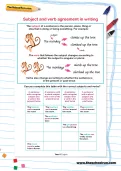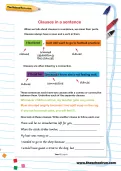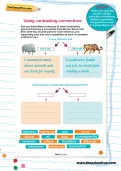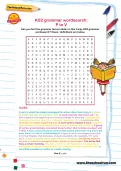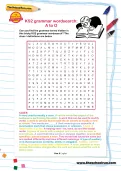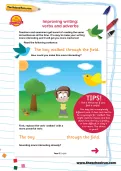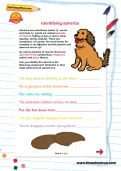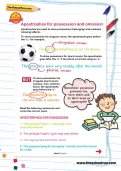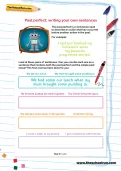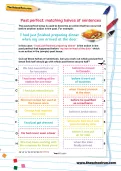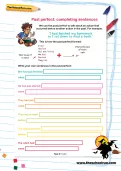Can you find the grammar terms hidden in this tricky KS2 grammar wordsearch?
or
Register to add to your saved resources
Can you find the grammar terms hidden in this tricky KS2 grammar wordsearch?
or
Register to add to your saved resources
Teachers and examiners get bored of reading the same old sentences all the time. It’s easy to make your writing more interesting and it will get you more marks too! Try and make the sentence 'The boy walked through the field' more interesting by using powerful verbs and adverbs.
or
Register to add to your saved resources
Already a subscriber? to view this content.
As well as adverbs of manner there are adverbs of time (yesterday), frequency (often) and place (there). Can you identify the adverb in the following sentences? Underline it, then state which kind of adverb it is.
or
Register to add to your saved resources
Already a subscriber? to view this content.
Etymology is the study of the origin of words and the way in which their meanings have changed throughout history. Complete the worksheet Deduction in reading comprehension, then choose five of the Oliver Twist words you highlighted and fill in this worksheet with the meanings
you guessed.
or
Register to add to your saved resources
Already a subscriber? to view this content.
Do you know all the occasions when capital letters should be used? Read the following sentences and circle any letters that should be capitals.
or
Register to add to your saved resources
Already a subscriber? to view this content.
Apostrophes are used to show possession (belonging) and omission (missing letters). To show possession for singular nouns, the apostrophe goes before the ‘s’. To show possession for plural nouns, the apostrophe goes after the ‘s,’ if the plural is formed using an ‘s.’But to show possession for irregular plural nouns (women, men, children, mice), the apostrophe goes before the ‘s’. Read the following sentences and circle the correct word.
or
Register to add to your saved resources
Already a subscriber? to view this content.
The boy walked through the field.... a bit of a boring sentence, yes? Can you make it more interesting by first adding an adjective, then a simile and then a metaphor.
or
Register to add to your saved resources
Already a subscriber? to view this content.
Can you spot the difference between an active and passive verb? Read the following passage and underline all the active verbs, then circle all the passive verbs.
or
Register to add to your saved resources
Already a subscriber? to view this content.
Look at each of the following pictures. Can you write a simple, compound and complex sentence to go with each one?
or
Register to add to your saved resources
Already a subscriber? to view this content.
A main clause can stand on its own and make complete sense. It is a simple sentence. A subordinate clause depends on the main clause to make sense. The following sentences are all missing their main clauses. Can you write them in where you think they should go?
or
Register to add to your saved resources
Already a subscriber? to view this content.
Synonyms are words that have similar meaning. When we write a non-fiction text, we often need to use synonyms so that we do not keep repeating the same word. Read through this passage. Every underlined word can be paired a synonym (also underlined) in the text. Can you find all the pairs of synonyms?
or
Register to add to your saved resources
Already a subscriber? to view this content.
Synonyms are words that have similar meaning; antonyms are words with opposite meanings. Each of the following sentences contains either a pair of synonyms or a pair of antonyms. Underline each pair of words and then write in the box beside it whether they are synonyms or antonyms.
or
Register to add to your saved resources
Already a subscriber? to view this content.
A subordinating conjunction introduces a subordinate clause (a clause that does not make sense on its own). Can you put each of these conjunctions into the gaps in the sentences below?
or
Register to add to your saved resources
Already a subscriber? to view this content.
A simple sentence consists of just one clause. A compound sentence consists of two main clauses of equal weight joined by a conjunction. A complex sentence is made up of a main clause and one or more subordinate clauses. Conjunctions such as because, although, until are usually used to link the subordinate clauses to the main clause. Look at these sentences. Can you tick the right-hand column to show whether they are simple, compound or complex?
or
Register to add to your saved resources
Already a subscriber? to view this content.
The past perfect is a verb tense that is used to describe an action that has occurred before another action in the past. Cut out these sentences. Which ones include verbs in the past perfect?
or
Register to add to your saved resources
Already a subscriber? to view this content.
The past perfect is a verb tense used to describe an action that has occurred before another action in the past. Look at these pairs of sentences. Can you rewrite each one as a sentence that contains both the past perfect and the simple past tense?
or
Register to add to your saved resources
Already a subscriber? to view this content.
The past perfect tense is used to describe an action that has occurred before another action in the past. Cut out these halves of sentences. Can you work out which past perfect tense first half should go with which past tense second half?
or
Register to add to your saved resources
Already a subscriber? to view this content.
We use the past perfect to talk about an action that occurred before another action in the past. Can you write your own sentences in the past perfect?
or
Register to add to your saved resources
Already a subscriber? to view this content.
A clause is a group of words that contains a subject and a verb (a doing word). A main clause makes sense on its own. A subordinate clause is dependent on a main clause and does not make sense on its own. Cut out the (blue) main clauses, the (orange) conjunctions and the (purple) subordinate clauses. Match them up to make six sentences that make sense.
or
Register to add to your saved resources
Already a subscriber? to view this content.
